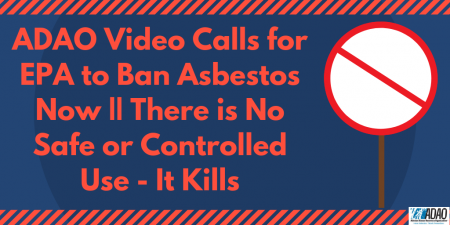“Mesothelioma is a miserable disease.” Debbie (1959-2013)
“I’m 58 and I have been murdered in slow motion. There is no safe form of asbestos and no safe level of exposure.” June (1950-2009)
“Look at me in my hospice deathbed.” Michael (1984 – 2014)
Posted on January 6, 2019
Every day, hundreds of Americans die from asbestos-related diseases. But not one day goes by when the loved ones of those who died — like myself — don’t feel some type of anger knowing these deaths were entirely preventable.

The video you are about to watch highlights the dangers of asbestos and how the Environmental Protection Agency (EPA) continues to balk on banning the lethal chemical, which has led to the deaths of hundreds of thousands of Americans.
While watching, you will learn about individuals who were killed by asbestos — people we call Mesothelioma Warriors.
They are called Mesothelioma Warriors because their stories are those of fighters – heroes who battled the treacherous pain and suffering of Mesothelioma until the very last moment. Their courage was boundless and bottomless, and – in a way – has never ceased. The words and voices of these Warriors will never truly be silenced.
June will never be silenced. “I’m 58 and I have been murdered in slow motion,” she says in this video. Before she died in 2009, this Mesothelioma Warrior left behind a truth that will never be extinguished: “There is no safe form of asbestos and no safe level of exposure.”
June’s fight helps us see all the dimensions of this disease. Mesothelioma isn’t merely reserved for construction workers who labored long hours in asbestos-filled buildings – you don’t have to work with it to get sick. Throughout her courageous and outspoken life, June never worked with asbestos – just like a majority of other victims.
Steve McQueen was a decorated actor who was nominated for an Academy Award. Warren Zevon was a successful musician. Mesothelioma killed them both, demonstrating that even those we imagine to have an inviolably low chance of being exposed to asbestos – such entertainers and artists – are still vulnerable to this carcinogen.
Michael, whose battle with Mesothelioma came to an end at age 30, is another exemplary Warrior. “Look at me in my hospice deathbed,” you will hear him say – frustration gripping him as he knows his struggle was – in every conceivable manner – preventable.
A lack of asbestos regulation is to blame for these deaths, plain and simple. While corporations continue to see dollar signs in this lethal fiber – and while the EPA continually fails to ban it outright – Warriors continue to suffer from an avoidable illness. As long as there is no ban, asbestos imports will continue, and so will asbestos-related deaths.
When the EPA attempted to ban asbestos in 1989, the ban was overturned because judges believed it was unfair to polluters. According to the courts, the EPA appeared to be prioritizing “the number of lives saved” over “adverse economic effects,” and this was “flawed” policy. With President Trump’s EPA composed of many former lobbyists for these same industries, a ban looks further out of reach. President Trump has testified that asbestos is nearly 100 percent safe, but he’s wrong. It’s lethal.
Industries have turned away from asbestos, not because it is illegal, expensive or difficult to obtain, but because the health risks are so great that the liability of continued use is unmanageable. Asbestos continues to poison and claim the lives of workers, and any manufacturer with half a conscience switched to safer substitutes long ago, in order to help lessen the asbestos-related death toll.
The EPA must institute a non-exemption ban on asbestos, and we must continue to pressure them just as June and Michael did.
Just as Debbie did. Before her death in 2013, Debbie spoke truth to power. She left absolutely nothing up to the imagination. She turned her anger, pain, and illness into action. “Mesothelioma is a miserable disease,” she told us.
As a mesothelioma widow, I’ve joined a community of those who have lost loved ones to asbestos. We are a strong community advocating for a ban, spreading awareness about the struggles our loved ones have faced, and fighting to prevent asbestos-caused diseases. We share a common story, but we are ultimately part of a larger narrative – one brought on by preventable diseases. If we don’t act soon, our story could become yours.
Now, is the time to fight for our lives.
Linda Reinstein
Social Networks
